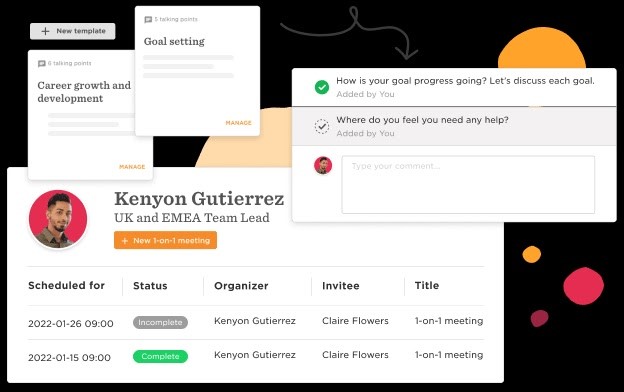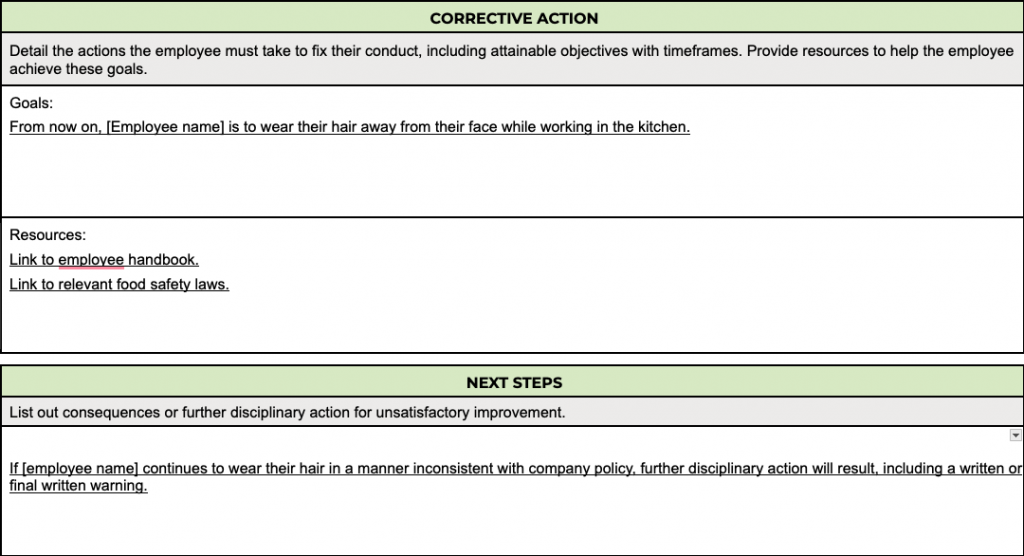Disclaimer: This article is not intended as legal advice. Please seek counsel from an employment law attorney to understand the requirements for your specific employee disciplinary action situation.
Key takeaways
What is the employee disciplinary action process?
The employee disciplinary action process is a series of corrective actions companies take following an employee’s unwanted behavior or violation of company policies or procedures. The goal is to correct issues before they worsen, not to punish, humiliate, degrade, or demotivate employees.
Although uncomfortable for human resources (HR) teams and people managers, having an employee disciplinary action process is necessary for all companies. With the right one in place, you can improve your compliance with labor laws, ensure employee productivity, and maintain safe working environments.
When to use disciplinary action
While certainly not exhaustive, the list below includes some of the most common examples that warrant the employee disciplinary action process.
*Note: some of these examples may warrant immediate termination depending on their severity.
Let’s say you have a call center business with a company policy requiring employees to shut down their computers at the end of the day. This is important because the computers include sensitive, HIPAA-protected data from clients in the medical industry and a third-party maintenance crew comes in every night after hours to clean.
If you walk in one morning and notice that one of your employees did not turn off their computer after being trained on the policy, you may need to start the employee disciplinary process with a verbal warning.
When not to use disciplinary action
The disciplinary action process is not always the answer for every incident that occurs in the company. For example, it may not be the best approach to fix behavioral issues related to someone’s personality, like being too direct or forthcoming in meetings.
Similarly, performance issues, like failing to meet key performance indicators (KPIs) or objectives and key results (OKRs), don’t always qualify for disciplinary action. Unless you can prove it’s intentional, addressing poor performance through focused manager-employee one-on-ones, further training, or performance improvement plans (PIPs) can be more effective. You may even learn their poor performance results from work practices that contribute to burnout or employee unhappiness.
Gross misconduct or illegal acts may also warrant immediate termination instead of the disciplinary action plan process. For example, intentional destruction of property or purposefully injuring another may warrant immediate termination or legal repercussions instead of your typical corrective steps.
Let’s say you’re a foreperson at a manufacturing plant, and your team’s goal is to assemble 50 products a day. Each of your team members must first fabricate several smaller parts to produce the larger product.
One of your team members consistently fails to meet this daily goal compared to the rest of their teammates. Instead of immediately disciplining them for their failure to meet objectives, consider the resources you can provide the employee to get them to where they need to be, such as extra training or more frequent check-ins to address concerns or questions.
Approaches and types
Most employee disciplinary action plans take one of three approaches: positive, progressive, or a combination of both.
Positive discipline highlights the employee’s positive behaviors during disciplinary conversations instead of reprimanding them. Managers balance this with employee feedback and constructive criticism to change behaviors. Employees also take part in selecting or creating any corrective actions. If their behavior improves, employees receive positive reinforcement through recognition and rewards.
Progressive discipline is a rigid set of steps that HR departments and managers follow where disciplinary actions become more severe as employees continue the unwanted behavior.
Combining positive and progressive disciplinary techniques allows employers to take a more nuanced approach to employee misconduct or behavioral issues. For example, positive discipline can inform disciplinary conversations and strategies for recognizing employees as they improve. Meanwhile, progressive discipline tactics ensure discipline remains fair and consistent across employees in the same or similar situations in the workplace.
There are also various types of employee corrective actions. Below are some of the most common.*
*Note: Be careful if you have an employment contract with the employee or a collective bargaining agreement (CBA). You may be unable to take particular disciplinary action under these contracts.
Employee disciplinary action template download
Download our employee disciplinary action template for free:
Employee disciplinary process steps
The best disciplinary action plan for your business requires collaboration between managers, HR teams, and executives and a commitment to equitable and consistent processes among employees in similar situations. Use the steps below as a guideline for building out your disciplinary action process.
1. Review the laws
Most states, except for Montana, are at-will. At-will means you can fire an employee with or without reason, as long as it is not illegal. Disciplinary action is the same unless you have a CBA or employment contract that prevents you from taking specific steps.
However, you should be familiar with the laws of the states where your employees work. For example, most states prevent you from disciplining or firing employees for refusing to violate state law. Some examples include disciplining an employee for filing for workers’ compensation or refusing to come to work because of jury duty obligations.
Federal laws on disciplinary action
Federal laws do not prevent you from taking employee disciplinary action. However, you cannot discipline employees for situations outlined by the following laws.
Note: Some states include equivalent laws to the above. As a rule, always follow the law that provides more employee rights and protections.
2. Create a disciplinary action policy
You will need to align with all relevant stakeholders when creating your disciplinary action policy. Because it affects employees’ tenure with the company, your executive teams must agree on the policy’s approach, scope, and list of progressive discipline steps.
At a minimum, your disciplinary action policy should include the following elements.
These statements clarify the relationship between you and your employee. For example, if your employee works in an at-will state, you should note that their employment is at-will, and either you or the employee can terminate the relationship at any time, with or without reason. Or, note the terms of their employment relationship based on any contracts or CBAs.
These are the stages of your disciplinary action process, starting from the least severe to the most severe consequences. Each step should include the manager’s, HR staff’s, and employee’s responsibilities and include examples of behaviors that might warrant starting at a particular step.
You may need to investigate incidents, behaviors, offenses, or complaints before taking disciplinary action to understand the best course of action. Detail this process, including who is involved in the investigation and response turnaround times.
This details how employees can report a workplace concern or complaint to management. Like with the investigation process, explain who employees should contact, what they need to provide, and response turnaround times. You should also include language noting that employees can report these concerns without fear of retaliation.
With each step, make clear what managers or HR staff need to document for the worker’s employment file. For example, typical documentation practices include:
- Basic employee information (e.g., name, title/role, department, manager name, and effective dates).
- Description of the infraction, including supporting evidence.
- Clear, relevant, and time-bound goals to correct the behavior.
- Resources to help the employee succeed.
- Next steps in the disciplinary process should the behavior continue.
- Areas for employees, managers, and reliable witnesses to sign in acknowledgment.
- Space for employees to provide feedback if they disagree with the disciplinary action.
Although you might indicate what offenses warrant starting at various steps in the disciplinary process, it’s impossible to predict every situation or behavior. To show this, include a statement that you hold the right to skip or combine steps in the disciplinary process based on the seriousness of the infraction.
Explain the termination process should the employee’s behavior result in dismissal, including who approves the decision. You should also disclose relevant offboarding processes, such as benefits termination, last check procedures, severance pay, filing for unemployment, and returning company equipment.
Following any disciplinary action, detail how long employees have to submit an appeal. The appeal process should outline what should be included in the appeal, how long after the disciplinary action they have to submit any appeal (usually five business days), who should receive the appeal, and the response turnaround time.
If you find drafting your employee disciplinary action policy daunting, you can leverage services like professional employer organizations (PEOs), employers of record (EORs), or employment law attorneys for help. Alternatively, software platforms like SixFifty walk you through creating company policies unique to you while remaining compliant with federal and state laws.
Learn more about SixFifty in the video overview below:
3. Conduct a workplace investigation
A workplace investigation is a process to help understand the who, what, when, where, why, and how of an employee incident or offense. You may need to conduct a workplace investigation to determine whether an employee violated company policies before taking disciplinary action. Situations where it’s unclear who is at fault or complaints of employee wrongdoing are examples of when you should conduct a workplace investigation.
If the incident or allegations are serious, such as sexual harassment, you may need to place the accused on a temporary suspension or leave of absence to look further. The length of time should be reasonable and follow what you outlined in your policy.
During this time, learn as much about the incident as you can. Interview anyone involved and gather written witness statements. You should also collect other evidence like videos, emails, or texts from relevant company sources. Consulting with employment law attorneys is also helpful for more complicated or sensitive situations.
With evidence in hand, you will need to decide where to start in your disciplinary action process. If the investigation reveals that the employee’s behavior was a minor infraction, you might start from step one in your disciplinary action plan. On the other hand, gross misconduct may mean you skip your usual steps and go straight for termination.
4. Have a one-on-one meeting
The first step of most disciplinary action plans is a one-on-one meeting between the employee and their manager. Sometimes referred to as counseling sessions, managers use these informal meetings to notify employees of minor infractions. The goal is to inform employees of the unwanted behavior and quickly course-correct. It is also an opportunity to explain the negative effects of their behavior on the company, other employees, or the workplace.
These meetings should be an open dialogue between you and the employee and follow constructive feedback best practices. They should also occur as soon as reasonably possible after the offense so that the employee can associate their actions with your feedback.
Use this time to ask the employee questions and understand the reasoning for their actions — you might even realize your implicit biases are clouding your judgment.
For example, during your conversation with an employee on their excessive tardiness, you might realize their lateness resulted from taking multiple kids to school on time in the morning. This challenges your prior belief that all tardy employees are “lazy.” With this knowledge, you can work with the employee to help them get to work on time, such as highlighting your commuter benefits or adjusting their start and end times.
Although these initial conversations are more informal, you should still document them, such as a quick note in the employee’s personnel file. Most HR software lets you upload documentation directly into employees’ electronic profiles. Other platforms, like Bob, let you schedule impromptu or regular meetings and create agendas, which help streamline and document disciplinary conversations for reference later.

5. Issue a formal warning
The next step is issuing a formal warning if the employee’s unwanted behavior escalates after two to three informal conversations. Formal warnings are official records of the employee’s infraction placed in their personnel file.
Formal warnings consist of both a meeting with the employee plus written documentation. Because this is the first official record of disciplinary action, it’s a good idea to include a reliable witness in the meeting with the manager and employee. Usually, that’s someone from the HR department, but it can also be another manager or administrator willing to bear witness.
The conversation should also cover the following:
Documentation of the warning should also include these same elements, plus an area for the manager, witness, and employee to sign and date.
You should also add a refusal acknowledgment section of the form should employees disagree with the warning. Employees can sign here to acknowledge they received the warning but disagree with it. You can also offer space for employees to explain why they disagree.
Remember to provide ample time for the employee to dispute or explain their side of the issue as you would during regular manager-employee conversations. Actively listen to their concerns and outline your appeal process every step of the way. Although some employees may offer excuses, others may have a legitimate need for accommodation, requiring follow-up conversations with HR or the legal team to resolve.
Most disciplinary action plans require two to three formal warnings before progressing to the next step. Some companies also distinguish between verbal and written warnings, with verbal warnings a less severe first step.
Despite the name, verbal warnings should follow the same process as written warnings, including thorough documentation. Besides helping you in the event of a lawsuit, employees can reference it to understand their expectations going forward.


6. Take last-chance actions
A last-chance action is the step in your disciplinary policy before termination. It occurs if the employee continues exhibiting behavior or performance issues after prior conversations and formal warnings.
Depending on your disciplinary action policy, what you decide to take as your last-chance action can differ. Some of the most common include:
Like formal warnings, document whatever last-chance action you take, including what led to the decision. Hold a conversation with the employee along with a reliable witness. Stress to the employee that this is their last chance to improve and that further infractions could lead to termination.
7. Recommend for termination
Termination is the last step in your disciplinary process. It occurs if the employee continues the same offenses after you’ve followed all prior disciplinary steps and provided ample resources and support to help the employee improve.
Because termination comes with several legal consequences, it’s always wise to consult with your HR department or employment law attorney before you have the termination conversation with the employee. If you have employment practices liability insurance (EPLI), check if you have access to an employer hotline to review the facts of your case and ensure termination is warranted.
Although unfortunate, remember that termination may be the best option if you followed the steps in your disciplinary action policy and did everything in your power to help the employee improve. Termination allows you to find a more effective team player and may even improve team morale.
Nervous about conducting the termination conversation? Learn tips and strategies to prepare for the conversation and hold an effective meeting in How to Fire an Employee (and Stay Out of Trouble).
8. Record your decisions and maintain consistency
Every disciplinary action or termination decision you make sets a precedent. Following your policy allows you to remain consistent with all employees in the same or similar situations. Record any deviations from policy and your reasoning for future reference.
Beyond that, a standardized disciplinary procedure you follow demonstrates your commitment to treating all employees fairly and consistently according to their circumstances.
Employee disciplinary action FAQs
Managing the employee disciplinary action process
Managing the employee disciplinary action policy can be stressful. It becomes even more so as your company grows and segments into different departments, divisions, and locations. Despite this, you must maintain and follow the same disciplinary procedures for all your employees.
Investing in effective HR software can simplify disciplinary management as you expand. Most platforms include a centralized human resources information system (HRIS) for tracking and storing personnel data and monitoring employment changes. Other features include policy templates, automated workflows, and e-signature capabilities for efficient document retention.
Training your managers and developing your HR department are also great strategies. Learning management systems (LMSs), like Coassemble, allow you to create courses for teaching leaders about the disciplinary process, including how to complete the necessary documentation. As a result, you can prepare your managers to handle situations, improve policy consistency, and foster more effective and constructive conversations with direct reports.

Interested in digitizing your disciplinary action process? Explore our HR Software Guide for platforms that fit your unique needs.





